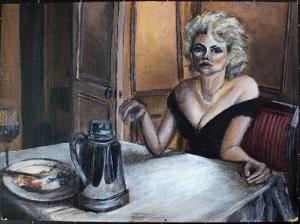Please use this identifier to cite or link to this item:
http://hdl.handle.net/10267/28660

Full metadata record
| DC Field | Value | Language |
|---|---|---|
| dc.contributor.author | Rotter, Rachel | - |
| dc.date.accessioned | 2017-02-14T16:27:26Z | - |
| dc.date.available | 2017-02-14T16:27:26Z | - |
| dc.date.issued | 2017-02-08 | - |
| dc.identifier.uri | http://hdl.handle.net/10267/28660 | - |
| dc.description | This image was photographed and uploaded to DLynx in the Visual Resources Center during spring 2017. | en_US |
| dc.description.abstract | This is a digital photograph of Rachel Rotter's painting. It was submitted as the first critiqued assignment, "Photo-volution," on February 8, 2017 in Erin Harmon's Intermediate/Advanced Painting class. The artist's statement reads: "A woman, out of focus and sheathed in purple gloom, sits alone at a table. Her companions are few: a wine glass, a plate, and a carafe – all empty. Beyond this space there seems to be another world, alluded to by the open door and violet expanse beyond, but it is not known to the viewer. In the right-half of the room which holds the figure, the brush stroke is murky and slow to show that she is out of focus. Conversely, the left-half of the room has speed and clarity to capture the most important parts of the painting – the empty place setting. There is also significance in the scale of the carafe relative to the woman – they are nearly the same size. This effect lengthens the room and pushes the woman back into the recesses of darkness. Thus, through color, scale, and brushstroke, there is light and movement and gaiety but also the stilled dusk of isolation. This is more than a painting about solitude; it is a painting about sadness and disjointedness. That sentiment is shown through the contrast of color. Where part of the work, rather the inanimate part, is cast in softer pastels and warm hues giving it an air of joy and echoing that of Wayne Thiebaud, the animate part of the work, that is the part holding the figure, is rife with blurred lines etched in deep blues and purples. To me, this connotes despair and confusion. Conclusively, this piece explores the use of photography as a means to collect images and summarily distort them. It also explores the use of brushstroke and color to convey meaning. This painting signals the inception of my exploration of the feminine body and how I might change and distort it through visual processes. My successes lie in the use of color as a sole gradient – there is no black. From this, however, I decided to further explore color and my attraction to its aggressiveness while also attempting to better understand where a painting may need something and why." | en_US |
| dc.format.extent | 12" x 16" | en_US |
| dc.language.iso | en_US | en_US |
| dc.publisher | Memphis, Tenn. : Art, Department of, Rhodes College | en_US |
| dc.rights | Rhodes College owns the rights to this digital material which is made available for educational use only and may not be used for any non-educational or commercial purpose. Approved educational uses include private research and scholarship, teaching, and student projects. For additional information please contact archives@rhodes.edu. | - |
| dc.subject | Student Artwork | en_US |
| dc.subject | 2017 Spring | en_US |
| dc.subject | Paintings | en_US |
| dc.subject | Art and Art History, Department of | en_US |
| dc.title | Critiqued Assignment #1: Photo-volution / "Solitude" | en_US |
| dc.type | Image | en_US |
| Appears in Collections: | Student Artwork | |
Files in This Item:
| File | Description | Size | Format | |
|---|---|---|---|---|
| 20170208_int_adv_ptg_photovolution_rachel_rotter_22.jpg | 882.37 kB | JPEG |  View/Open | |
| 20170208_int_adv_ptg_photovolution_rachel_rotter_23.jpg | 864.42 kB | JPEG |  View/Open | |
| 20170208_int_adv_ptg_photovolution_rachel_rotter_24.jpg | 648.3 kB | JPEG |  View/Open | |
| 20170208_int_adv_ptg_photovolution_rachel_rotter_25.jpg | 925.15 kB | JPEG |  View/Open |
Items in DSpace are protected by copyright, with all rights reserved, unless otherwise indicated.